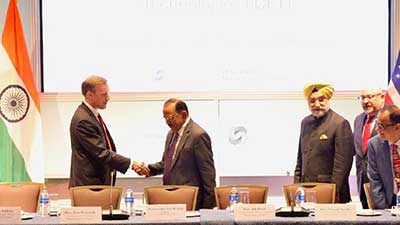Date: 03/02/2023
Relevance: GS-2: Bilateral, Regional and Global Groupings and Agreements involving India and affecting India’s interests; India-US relation.
Key Phrases: USA-India Relation, Initiative on Critical and Emerging Technologies (iCET), Defence Cooperation, Techno-economic Cooperation, Tokyo Summit, Quadrilateral Security Dialogue (Quad), Nuclear Sanction, Civil Nuclear Initiative, Bureaucratic Inertia, Technology Transfer, Technological Capabilities, Implementation Arrangement for a Research Agency Partnership, Robust Ecosystem of Innovation.
Context:
- Recently, A round of talks was held between India’s National Security
Advisor Ajit Doval and his American counterpart Jake Sullivan in Washington
concluded with the announcement of a new road map for deeper military
and techno-economic cooperation between the two countries.
- The USA-India initiative on Critical and Emerging Technologies (iCET) was the major focus of the talk.
Key Highlights:
- During the Tokyo summit of the Quadrilateral Security Dialogue (Quad) in May 2022, US President Joe Biden and Prime Minister Narendra Modi announced the iCET to elevate and expand their strategic technology partnership and defense industrial cooperation between the governments, businesses, and academic institutions of the two countries.
- A new Implementation Arrangement for a Research Agency Partnership was also signed between the National Science Foundation and Indian science agencies to expand international collaboration in a range of areas including artificial intelligence, quantum technologies, and advanced wireless to build a robust innovation ecosystem between the countries.
Initiative on Critical and Emerging Technology(iCET):
- The iCET is a partnership between India and the US to work together in developing important and new technologies.
- The iCET involves collaboration in a range of areas including quantum computing, semiconductors, 5G and 6G wireless infrastructure, and civilian space projects such as lunar exploration.
- The iCET process will be monitored and driven from the PMO in Delhi and the White House in Washington.
Cooperation in Defence Sector:
- India and the USA are also focused on cooperation in defence production.
- Much of this cooperation will need to be fleshed out in the months ahead
but one concrete measure of the making of a fighter jet engine in
India was announced.
- GE Aerospace has applied for an export license for jet engine production and phased transfer of technology to Indian entities.
- Washington promises to process this application expeditiously.
- This fits in nicely with Delhi’s plans to modernize its rusty defence industrial base.
History of High-technology Cooperation between India and USA:
- High-technology cooperation is not new for India and the USA but the
journey of cooperation has seen ups and downs over almost 70 years of the
time period.
- Cooperation in the 1950s and 1960s
- Early advances in India’s nuclear and space programmes in the 1950s and 1960s involved significant inputs from the USA.
- Era of Nuclear Sanction and Downfall of Cooperation
- The US nuclear sanctions from the 1970s steadily whittled down the extent of bilateral high-tech cooperation between India and the USA.
- Civil Nuclear Initiative renewed Cooperation
- The historic civil nuclear initiative of 2005 opened the door for renewed technological cooperation.
- Constraints in the Best Use
- Residual restrictions on technology transfer in Washington and Delhi’s political ambivalence and bureaucratic inertia prevented the best use of the new possibilities.
- Cooperation in the 1950s and 1960s
Way Forward:
- The iCET process will hopefully bring greater coherence to the round of India-US technological engagement.
- Lending urgency to the iCET is the growing convergence of Indian and US interests in managing the security, economic, and technological challenges presented by a rising and assertive China.
- India is also looking to reduce its over-dependence on Russian weapons and military technology and to produce more weapons at home in partnership with western countries.
- Working together on new and important technologies can lead to more business between India and the US, which can help the economy grow as it will bring more investment and employment opportunities for both countries.
- The iCET will boost India’s technological capabilities with access to cutting-edge technology and expertise in areas that are critical and emerging in nature.
Conclusion:
- If implemented with speed and purpose, the bilateral Initiative on Critical and Emerging Technologies (iCET) could lend a new strategic depth and breadth to the expanding engagement between India and the United States.
Source: IndianExpress
Mains Question:
Q. The bilateral iCET could lend a new strategic depth and breadth to the expanding engagement between India and the United States. Critically analyze the statement in light of the significance of the iCET. (250 Words).







